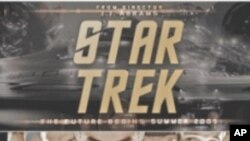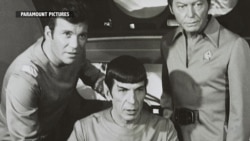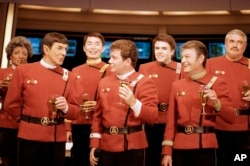Fifty years ago, on September 8, 1966, Star Trek was born.
The television show was set in the future and was about the crew of the USS Enterprise, which was on a five-year mission of space exploration. Week after week, fans watched Captain James T. Kirk and his crew "boldly go where no man has gone before."
In real life, the era of space exploration has been underway since 1957 with Sputnik’s launch in Russia, and it was in full swing with Neil Armstrong’s lunar walk in 1969.
Star Trek used the stars as a blank canvas to tackle some of the huge societal changes of the time. Series creator Gene Roddenberry was a progressive, and his ideas were considered pretty radical for the times. By placing his show in space, he safely tackled concepts like civil rights, women’s rights, population control and the ethics of war at a time when American troops were fighting in Vietnam.
It didn't hurt that the show featured some of the best-ever cool tech. Michael Caruso, organizer of The Future is Here Festival, sponsored by Smithsonian magazine in Washington, says the show's innovations influenced real-life science.
WATCH: William Shatner on His 'Brother' Leonard Nimoy
Tech inspirations
“Star Trek has inspired a tremendous number of new technologies," he said. "The tricorder, the kind that Dr. Bones used to use to examine aliens, they actually have one of those now, and they developed one of those. There are all kinds of inventions and discoveries that have come out of Star Trek and other science fiction.”
But back in the 1960s the show was not yet a moneymaker. NBC studios pulled the plug on the show after three seasons, but it remained on TV in the form of reruns at home and abroad. Fans were catching on to its ideas and clever execution and were petitioning for the continuation of the series.
Members of the cast were becoming household names.
William Shatner was at the helm of the Enterprise as the bold and intuitive James Tiberius Kirk. His first officer, Mr. Spock, played to perfection by Leonard Nimoy, was a logically-minded half-Vulcan, half-human and served as the perfect foil to Kirk's impetuous nature. The sharp-tongued, heartwarming Dr. Leonard "Bones" McCoy was played by Deforest Kelley as a man in a state of constant exasperation, thanks to Mr. Spock’s emotionless logic.
Many a time the Enterprise’s resourceful engineer, Lieutenant Commander Montgomery "Scotty" Scott, played by James Doohan, saved the Enterprise and crew in the nick of time. Kirk’s phrase “Beam me up, Scotty” has become part of the American lexicon.
Move to the big screen
In 1979, Star Trek: The Motion Picture saw its national and international release. By then, Roddenberry’s brainchild had exploded in popularity the world over. Shatner said the franchise’s meteoric success had never been anticipated.
“The concept of making more Star Treks in terms of movies occurred. And each movie, they thought that was the last one. So nobody had any idea of the residual popularity that occurred,” he said.
Five more Star Trek films followed with the original crew. But Star Trek had already spawned different TV incarnations and soon-to-come films with a new cast.
Still, throughout the years, millions of fans stayed true to the original show and cast and were delighted when filmmaker and producer J.J. Abrams rebooted the original characters in the 2009 visual extravaganza, Star Trek. Abrams kept close to Roddenberry’s ideas, and the casting of Chris Pine as Kirk was reminiscent of Shatner’s personality.
Abrams’ second installment in 2011, Star Trek: Into Darkness, introduced Oscar-nominated Benedict Cumberbatch as the evil Khan (originally played by Ricardo Montalban), who is arguably one of the most iconic "bad guys" in the history of visual media.
Third installment
Star Trek's immense fan base is waiting for the third installment, the 3-D Star Trek: Beyond. Filmmaker Justin Lin, known for his work in Fast and Furious, directs the latest installment and departs from Abrams' commitment to the original characterizations of Roddenberry. Lin knows how to offer impressive special effects and how to choreograph breathtaking battle and fight sequences.
Unfortunately, his character development is lacking and his dialogue lacks substance. This is a chills-and-thrills summer blockbuster with a bigger and better spaceship and an impressive high-tech frontier Federation space station. But like the crew, the message that carried Star Trek is lost.
Star Trek fans who delight to puzzle over intergalactic dilemmas on values and choices will be gravely disappointed. The music, however, is superb and Rihanna, another Trekkie, interprets the theme song, "Sledgehammer" — one of the film’s few high notes.
Maybe Abrams will take back the franchise’s helm in the next installment. But chances are Abrams will still be knee-deep in his other project — the world's other space opera, the Star Wars franchise.











